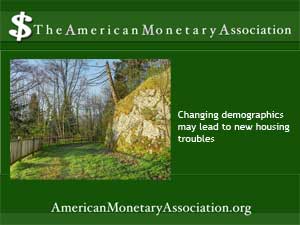 The landscape of American society continues to shift, with large numbers of the so-called baby boom generation headed toward retirement and minority populations becoming the majority in many areas.As these and other subsets of the US population intersect in various slices of the economy and culture, doors open to new opportunities– and, some researchers fear, new crises, especially in the still-vulnerable housing market.
The landscape of American society continues to shift, with large numbers of the so-called baby boom generation headed toward retirement and minority populations becoming the majority in many areas.As these and other subsets of the US population intersect in various slices of the economy and culture, doors open to new opportunities– and, some researchers fear, new crises, especially in the still-vulnerable housing market.
The baby boomers have been blamed for changes in society since they were old enough to walk, and now, as larger numbers of these postwar babies age, they’re continuing to force more shifts in the cultural and economic landscapes. Specifically, many people of this generation invested in the typical homes of the “American Dream:” large single-family homes, often in suburban areas within commuting distance to work.
Now, though, these homeowners are retiring and making plans for a new stage in life – and for many, that means selling those big suburban homes in favor of smaller urban dwellings, or a gypsy lifestyle that involves short term rentals. In view of the low inventory of available houses for purchase in many markets around the country, that should be a good thing – these kinds of homes could satisfy buyer demand fueled by low interest rates and improving economic conditions
But, according to a recent study by the University of Utah’s Metropolitan Research Center, that’s where the potential for crisis waits: will there be buyers for these homes? The upturn in demand for homes to purchase now is fueled by new households that finally have the financial stability to buy a house as well as many victims of foreclosure who are finally able to get back into the housing market. But there’s a catch: the rapidly expanding minority population may not be able to afford the homes these sellers are putting on the market.
That scenario, say the University of Utah researchers, could lead to a glut of unsellable homes on the market, as potential buyers look for smaller starter homes or fixer-uppers instead of these expansive suburban properties. In that event, sellers could end up having to accept far lower purchase prices than they expected – or they could end up trapped in homes they can’t sell at all.
This scenario has a bleak endpoint: large numbers of elderly homeowners forced to continue living in homes they can’t maintain as they age into the 90s and beyond, requiring more and more assistance for daily living. And on the other end of the spectrum, many younger famili8es with children are locked out of the opportunity to buy their own dream home.
But other trends in housing are at
work, too. Many retirees are becoming property investors, maintaining rental housing for those who choose or are forced to rent. And as other outcomes of the housing crisis such as the shadow inventory of foreclosed homes intersect with the changing demographics of American society, the only constant is change itself. For investors following Jason Hartman’s recommendations on building wealth through income property, that means new opportunities in an evolving marketplace. (Top Image: Flickr/Torvald_3)
The American Monetary Association Team

